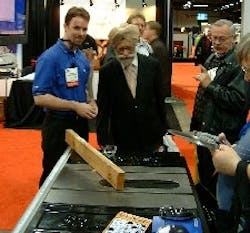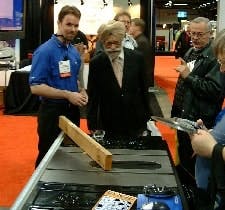NAM survey finds more worried manufacturers
A table saw uses a National Instruments solution to brake withing milliseconds at National Manufacturing Week 2006. The saw's detector sets up a sine wave, so if anything soft touches the blade, a capacitance change is sensed, and the blade stops in a few milliseconds, barely nicking the hotdog used as a finger's stunt double in the demonstration.
On the bright side, more than half of the surveys 349 respondents expect to increase capital spending and employment in 2006. Also, almost 75% report that theyre exporting products to other countries. These are all positive signs, adds Engler.
However, the biggest challenge for U.S. manufacturing are rising external costs associated with health care, materials and energy, which manufacturers are unable to transfer to product pricing. External costs burdens are having the biggest impact on manufacturers, lowering their profitability and tying up more funds that would otherwise be spent on investment, research and development, and new product lines, adds Engler. These costs are a significant and long-term problem for our nations manufacturers and our economy.
Tony Raimondo, chairman and CEO of Behlen Manufacturing Co. in Columbus, Neb., and a NAM board member, says energy is looming ever larger as a serious cost factor in his industry. The government encourages us to rely more and more on natural gas for energy, and then makes it virtually impossible to access more supplies of natural gas. The result is that we have the highest natural gas prices in the world.
Raimondo adds the U.S. must also get a handle on its health care costs. Were looking at double-digit cost increases every year on what is already a major cost item. This survey shows that the cost of non-wage compensation is having the greatest negative impact on manufacturers today, and by far the biggest item in that category is health care.
Finding the Qualified
The survey also found that, as the manufacturing sector continues to expand, its players are relying more on a high-performance workforce, and that qualified workers are getting harder to find. We began seeing this issue a few years ago, and its becoming more pronounced in subsequent surveys, adds Engler. Half of the surveys respondents have unfilled positions because they cant find qualified workers, and 70% of the new jobs that respondents anticipate creating will be for skilled production workers or highly educated professionals. The need for highly-educated professionals specifically has nearly doubled from 2005, and we anticipate it will continue to grow in the future.
If the U.S. is to preserve its position as a major economic power in the 21st Century, it must stay out in front of the innovation curve, and it will need a much better-prepared workforce to do so. Like every modern nation, the U.S. is deeply involved in globalization. Technology and competition will only increase Americas need to have access to highly skilled professionals, but our schools and training programs just arent doing the job.
Ronald Bullock, CEO of Bison Gear & Engineering Corp. in St. Charles, Ill., adds, I recently filled an engineers position that had been open for 18 months. Right now, I have at least five empty slots, some of which have been empty for months. I need more people to keep up with demand, but I cant just hire anyone off the street. This is complicated work. We need people with strong backgrounds in math, science and computers.
One way that manufacturers are competing more effectively with the rest of the world is by increasing their exports. The survey found that 73% of respondents are selling abroad. The survey also showed that 54% respondents expect their exports to stay the same in 2006, while 41% expect them to increase. Were seeing a much stronger commitment to exporting than in previous years, says Engler. This is a positive trend because manufacturing accounts for most U.S. exports, and offers our best hope for chipping away at the trade deficit.
View Survey Results


